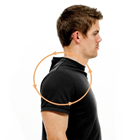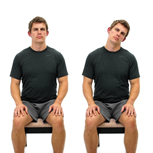Office Ergonomics & Exercise For Neck Pain Relief
Office work is inherently repetitive, and can require prolonged, awkward positions and repetitive motions to perform tasks throughout the workday. Due to the tendency toward repetitive work and sustained positions over a number of hours, it is not surprising that there is a relatively high instance of neck and shoulder pain in people who work in this setting. Studies have shown a correlation between impaired muscle function and weakness in the neck, and neck pain or certain types of headache. Other studies have implicated poor workspace ergonomics as contributing to neck and shoulder pain specifically. Addressing both ergonomic needs and postural strength can be helpful when attempting to manage or prevent pain associated with work in an office setting.
Organizing your workstation
In general, the body will respond best to repetitive tasks if they can be performed closer to neutral postures. Spending long periods of time or performing highly repetitive tasks in awkward positions is more likely to contribute to tissue strain due to increased and unnecessary tensile and compressive forces.
· Chair vs. desk height can be important. A well sized, supportive chair can assist with trunk support and maintaining an upright posture. It can also help position knees, hips and elbows at an ideal position (a little less than 90° angles) when working at a desk or computer. If height is a problem, a box placed under the feet is another way to stay supported.
· Keep your work in front of you. As much as possible, position yourself so your work can be performed directly in front of you. This is particularly important for computer work or any tasks that are performed repetitively or for a long time. If you have a large desk or multiple work areas on your desk, use a rolling or pivoting chair so you can position yourself in the most comfortable alignment. Having to repeatedly hold your head and neck in a rotated position to watch a computer monitor can add up over the course of an eight-hour day, contributing to neck pain and tension.
· Get close to your work. Position yourself close to your work surfaces and any equipment used. By keeping tasks close to your body and arranging frequently used objects in a convenient orientation, you can decrease the need for awkward reaching and body positions while minimizing repetitive reaching.
· Use equipment to your advantage.
o Monitor risers can help move computer screens into your natural line of sight and decrease neck strain from sustained flexed positions.
o Keyboard trays are a good way to move your input devices to you.
o Don’t forget visual strain. When people have trouble seeing things that are too small, we have a tendency to lean toward the screen. Setting your monitor close enough, setting your screen resolution large enough to be seen easily, or using zoom features as needed can not only decrease eye strain, but also make it less likely to push the head forward in order to see, introducing unneeded tissue stress.
Take breaks, change tasks. Having your workstation arranged to minimize strain and unnecessary repetitive movement is a good first step. But, as humans, we are built to move! If you have different types of tasks to do, breaking them up can make it easier on your body by changing the type of stress your tissues are under. Take microbreaks during the day. Taking one or two minutes every half an hour to an hour to allow yourself to get up and move around can be helpful. A few simple neck and shoulder exercises can help keep muscle tension in neck and shoulders under control
Strengthening
While stretching can be helpful in managing muscle tension and pain in neck and shoulders, research has demonstrated correlation between neck and shoulder strength and pain, where weakness in these areas was commonly seen in groups with neck pain. The addition of strength training can be more effective than stretching alone in workers with neck pain, making exercises that strengthen around the shoulders and the muscles in the neck an important addition to your routine, particularly if you spend time in a setting that is prone to contribute to pain in these areas. A physical therapist can help you create a personalized strengthening program to help address these issues.
Written by: Jesse Dupre, DPT
References:
Johnston V, Chen X, Welch A, et al. A cluster-randomized trial of workplace ergonomics and neck-specific exercise versus ergonomics and health promotion for office workers to manage neck pain - a secondary outcome analysis. BMC Musculoskelet Disord. 2021;22(1):68. Published 2021 Jan 12. doi:10.1186/s12891-021-03945-y




